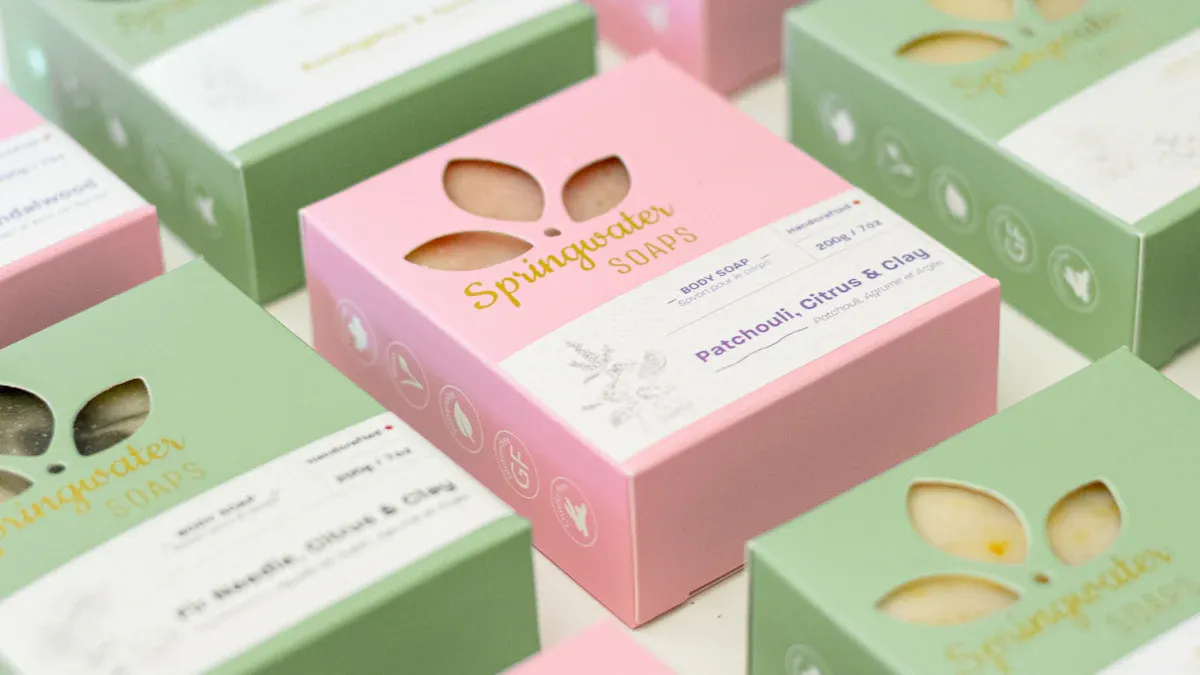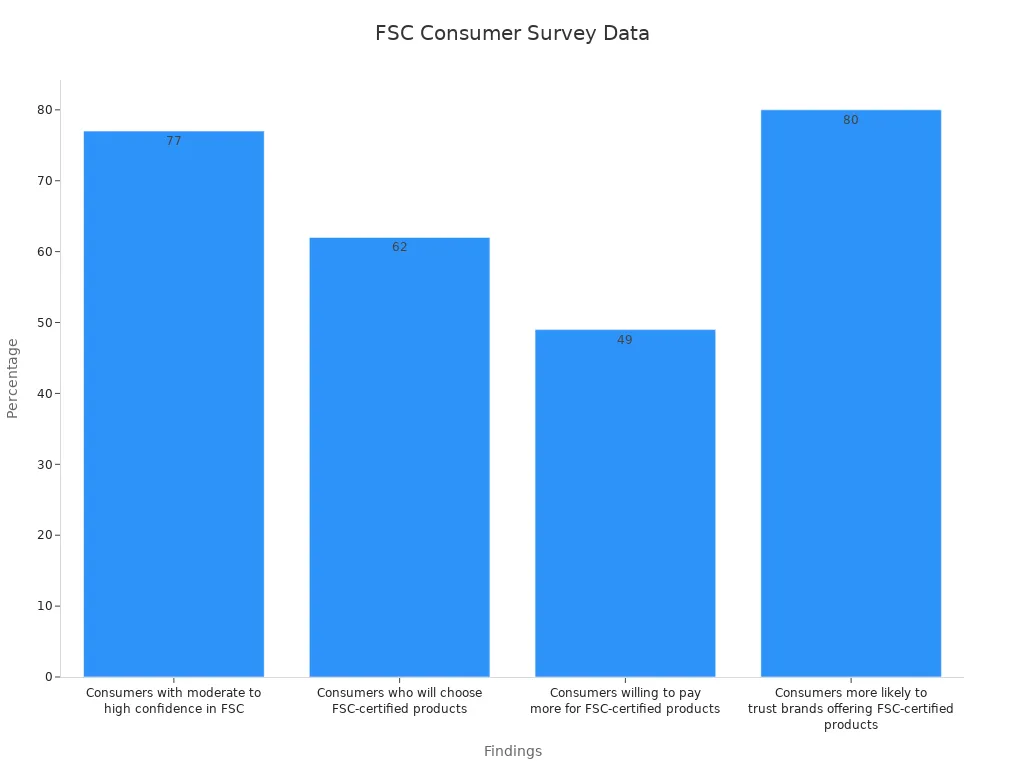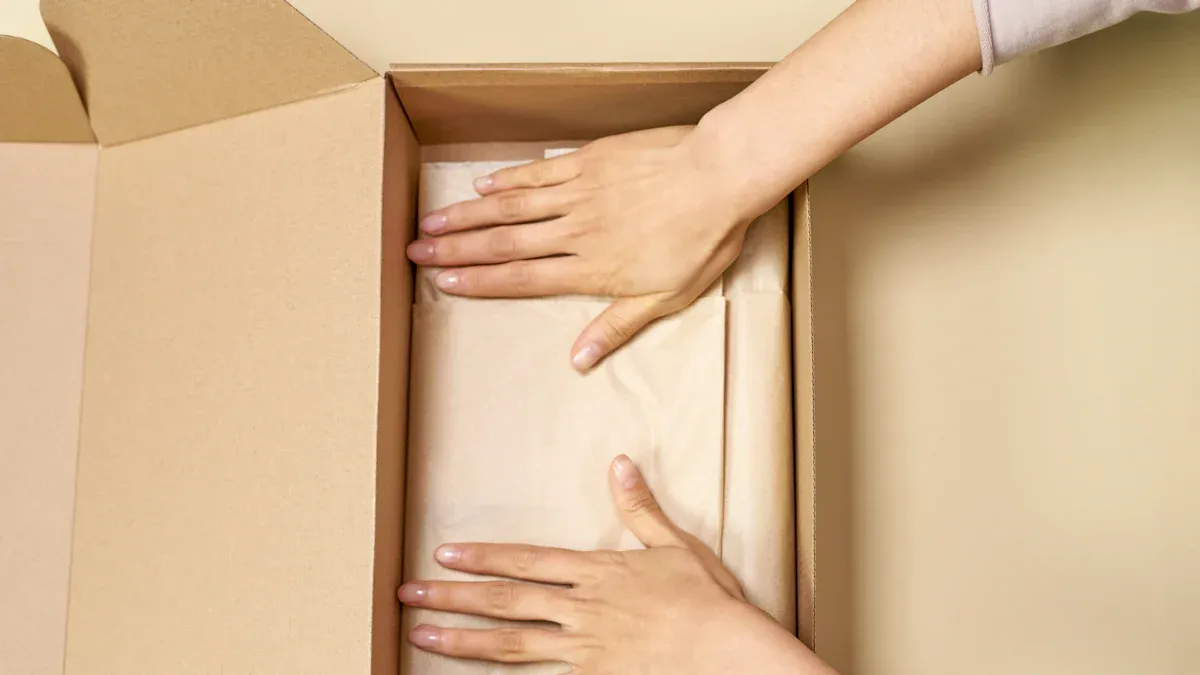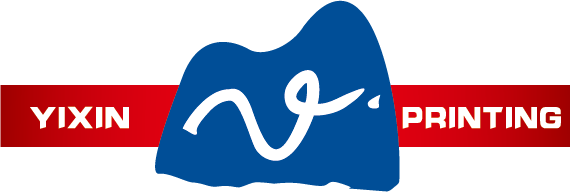Sustainability has become a key focus for consumers and brands alike. You might wonder if recycled and FSC-certified materials can truly meet the high expectations of luxury packaging. Today, 78% of consumers value sustainability, and 62% actively seek eco-friendly products. With sustainable goods growing 2.7 times faster than non-sustainable ones, the demand for greener solutions is undeniable. Yet, achieving the elegance and quality expected in luxury paper box designs remains a challenge. Striking the right balance between environmental responsibility and premium aesthetics is essential for brands aiming to stay relevant in this evolving market.
Key Takeaways
Being eco-friendly is important for luxury brands. 78% of buyers prefer green products, so brands must go green.
Recycled and FSC-certified materials can still look fancy. Using good methods, these materials can be strong and pretty.
New designs and tech make unboxing more fun. Things like NFC chips and custom looks help connect with buyers.
Defining Luxury Standards in Sustainable Packaging
Aesthetics and Brand Identity
Luxury packaging must captivate the eye while reflecting the essence of a brand. You expect packaging to tell a story, one that aligns with the values and identity of the product it holds. Aesthetic appeal plays a critical role in creating this connection. For instance, Frezyderm, a skincare brand, designed packaging that combined a clinical yet elegant look. This approach not only reinforced their brand identity but also built consumer trust and boosted sales. Such examples highlight how thoughtful design can elevate sustainable packaging to meet luxury standards.
Sustainability does not mean compromising on beauty. Recycled and FSC-certified materials can achieve premium finishes with the right techniques. Embossing, foil stamping, and creative textures can transform eco-friendly materials into works of art. By focusing on these details, you can ensure that sustainable packaging maintains the sophistication expected in the luxury market.
Durability and Functionality
Luxury packaging must also deliver on durability and functionality. You want packaging that protects its contents while maintaining its pristine appearance. This is especially important for luxury products, where the unboxing experience is part of the allure. Sustainable materials must meet rigorous standards to ensure they perform as well as traditional options.
Specific tests evaluate the durability of luxury paper boxes. These include micro-indentation measurements to assess hardness, scratch tests to measure resistance, and reuse wear experiments to simulate repeated use.
By meeting these metrics, sustainable packaging can ensure durability without sacrificing luxury. When you combine functionality with sustainability, you create a product that aligns with both consumer expectations and environmental goals.
Recycled Materials in Luxury Paper Box Packaging

Benefits of Recycled Materials for Sustainability
Recycled materials offer significant advantages for sustainability. By reducing the need for virgin plastic production, they help lower carbon emissions. This approach also minimizes landfill waste, making it an eco-friendly choice for packaging materials. For example, Morris Packaging incorporates up to 45% recycled content in its products, effectively reducing environmental impact. Using recycled paper or plastics not only conserves resources but also aligns with the growing demand for sustainable packaging solutions.
When you choose recycled materials for luxury paper box designs, you contribute to a circular economy. This practice supports waste reduction and promotes the reuse of valuable resources. It also enhances your brand's commitment to sustainability, which resonates with environmentally conscious consumers.
Challenges in Achieving Luxury Standards
Despite their benefits, recycled materials face challenges in meeting luxury standards. Balancing tradition with innovation can be difficult, especially when craftsmanship plays a crucial role in luxury packaging. Educating consumers about sustainable materials is another hurdle, particularly in regions where environmental awareness is low. Additionally, the lack of standardized sustainability metrics complicates informed decision-making for both brands and consumers.
High upfront investment is another challenge. Transitioning supply chains and adopting new technologies require significant resources. Scaling the use of recycled content in luxury paper boxes also demands collaboration with material producers and substantial capital. These factors can make it harder for brands to maintain profitability while meeting sustainability goals.
Examples of Successful Applications
Several luxury brands have successfully integrated recycled materials into their packaging. Giorgio Armani and Helena Rubinstein serve as prime examples. They have embraced eco-design principles and recyclability in their luxury paper box packaging. These efforts demonstrate how brands can overcome challenges and align with consumer demand for sustainable materials. By prioritizing corporate social responsibility, these companies have set a benchmark for others in the luxury sector.
Their success highlights the potential of recycled content to meet both sustainability and luxury standards. When you adopt similar practices, you not only reduce environmental impact but also enhance your brand's reputation in the competitive luxury market.
FSC-Certified Materials and Their Role in Sustainability
Understanding FSC Certification
FSC certification ensures that materials come from responsibly managed forests. The certification process involves advanced technologies like satellite monitoring and blockchain to track sourcing and production. FSC labels, such as FSC Recycled, FSC Mix, and FSC 100%, indicate varying levels of sustainability. These labels help you identify products that align with environmental responsibility. By choosing FSC-certified packaging, you support ethical supply chains and reduce environmental harm.
Environmental and Consumer Benefits
FSC-certified materials offer measurable environmental benefits. Studies suggest that Reduced Impact Logging (RIL) practices associated with FSC certification lead to lower environmental damage compared to conventional methods. However, long-term impacts remain under-researched.
Consumers also show strong support for FSC-certified products. A survey reveals that 62% of consumers prefer FSC-certified packaging, and 49% are willing to pay more for it. This preference highlights the growing demand for sustainability in luxury packaging.

Enhancing Brand Value with FSC-Certified Packaging
Using FSC-certified packaging enhances your brand's reputation. Luxury brands like Gucci and Stella McCartney have successfully integrated FSC-certified materials into their packaging. Gucci maintained its luxury image while improving sustainability ratings. Stella McCartney’s transition to recycled packaging positively impacted brand perception.
By adopting FSC-certified materials, you demonstrate environmental responsibility and align with consumer values. This approach not only supports sustainability but also strengthens your position in the competitive luxury market.
Overcoming Challenges in Sustainable Luxury Packaging
Material Performance and Resilience
Sustainable materials must meet the same performance standards as traditional luxury packaging. You expect packaging to maintain its structural integrity and visual appeal under various conditions. Rigorous testing ensures these materials can withstand environmental factors like temperature, humidity, and light exposure.
These tests ensure that sustainable packaging meets the durability and aesthetic expectations of luxury brands. By prioritizing material resilience, you can confidently adopt sustainable practices without compromising quality.
Cost Considerations for Luxury Brands
Switching to sustainable packaging often involves higher initial costs. Eco-friendly materials and production adjustments contribute to these expenses. However, the long-term benefits outweigh the upfront investment.
The initial costs of sustainable packaging can be higher due to the use of eco-friendly materials and necessary production adjustments. However, the long-term benefits include enhanced brand image, market differentiation, and increased consumer loyalty, which can lead to higher sales and revenue.
Brands like Ikea have demonstrated how optimizing packaging can lead to significant savings. As demand for sustainable practices grows, production costs will likely decrease, making it easier for luxury brands to adopt eco-friendly solutions.
Addressing Greenwashing and Transparency
Greenwashing poses a significant challenge in the sustainable luxury packaging sector. Consumers increasingly demand authenticity in sustainability claims. Studies reveal that skepticism arises from misleading green claims, prompting governments to enforce stricter regulations.
To address this, you should adopt transparent reporting on sustainable practices. Compliance with regulations like the EU Eco-design for Sustainable Production Regulation (ESPR) ensures credibility. By focusing on reducing, reusing, and recycling materials, you can align with consumer expectations and build trust.
Innovations in Sustainable Luxury Packaging

Emerging Eco-Friendly Materials
The rise of eco-conscious consumers has driven the development of innovative materials for sustainable luxury packaging. These materials not only reduce environmental impact but also maintain the luxury appeal that high-end brands demand. You can now find biodegradable plastics, recycled paper, and even cutting-edge options like mushroom pulp and seaweed plastic being used in packaging. These materials offer a balance between luxury and sustainability, ensuring that brands meet consumer demand for sustainability without compromising on quality.
Other trends include tactile packaging that enhances the sensory experience and biophilic designs that connect consumers to nature. Minimalist and maximalist styles coexist, catering to diverse preferences. Personalization has also become a key focus, allowing brands to create emotional connections with their audience. These innovations demonstrate how sustainable packaging design can evolve to meet both functional and aesthetic needs.
Design Innovations in Luxury Paper Boxes
Luxury brands are redefining sustainable packaging design with creative approaches that elevate the unboxing experience. Smart packaging technologies, such as NFC chips and QR codes, allow you to access digital content, creating an immersive interaction with the product. High-end perfume brands have introduced electric scent boxes with automated opening mechanisms, adding a futuristic touch to their packaging.
Tactile elements like embossed textures and eco-friendly finishes enhance the luxury appeal of paper boxes. Customizable designs, paired with sustainable paperboard solutions, offer brands the flexibility to align with their unique identity while addressing eco-conscious consumers. These innovations prove that sustainable luxury packaging can be both functional and visually stunning.
Case Studies of Sustainable Luxury Brands
Several luxury brands have successfully integrated sustainability into their packaging strategies. High-end perfume brands have seen a 20% increase in customer satisfaction by incorporating automated opening mechanisms into their packaging. Premium cosmetics brands have adopted customizable, eco-friendly designs, resulting in a 25% boost in repeat purchases. Additionally, tech-integrated boxes with features like NFC chips have increased product adoption rates by 15%.
Luxury fashion brands are also leading the way. One high-end retailer enhanced its ESG strategy to improve transparency and sustainability across its supply chain. Another brand revamped its approach to meet consumer demand for sustainability, setting a benchmark for others in the industry. These examples highlight how luxury and sustainability can coexist, offering inspiration for brands looking to innovate.
Recycled and FSC-certified materials have proven their potential to meet luxury packaging standards. Historical trends show a shift toward recyclable and FSC-certified boxboard, driven by research and development in sustainable practices. Modern consumers demand ethical sourcing and responsible manufacturing, pushing brands to innovate.
22% of consumers have boycotted brands over poor sustainability values.
Companies increasingly use biodegradable alternatives and advanced printing technologies.
Collaboration between brands and material producers will shape the future of sustainable luxury packaging. Environmentally conscious consumers will continue to influence this evolution, ensuring luxury aligns with sustainability.
FAQ
What makes FSC-certified materials better for luxury packaging?
FSC-certified materials ensure responsible sourcing from well-managed forests. They align with sustainability goals while maintaining the premium quality expected in luxury packaging.
Can recycled materials match the durability of traditional luxury packaging?
Yes, recycled materials can meet durability standards. Advanced testing ensures they withstand environmental factors like temperature and humidity without compromising structural integrity.
How do sustainable materials impact brand perception?
Sustainable materials enhance your brand's reputation. Consumers value eco-friendly practices, which can increase loyalty and differentiate your brand in the competitive luxury market.

